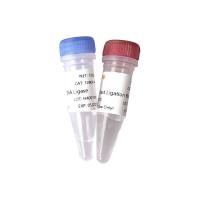Ligation of DNA with T4 DNA Ligase
互联网
1471
Since they are involved in such important processes as DNA replication, DNA repair, and DNA recombination, DNA ligases can be found in all living cells. Two prokaryotic DNA ligases have become indispensible tools in the fields of in vitro DNA recombination and DNA synthesis. DNA ligase from E. coli is a polypeptide with a molecular weight of 74,000 and is NAD-dependent. T4 DNA ligase is the product of gene 30 of the T4 phage, has a molecular weight of 68,000, and is ATP-dependent. Both enzymes catalyse the synthesis of a phosphodiester bond between the 3′-hydroxyl group and the 5′-phosphoryl group at a nick in double-stranded DNA. Of the two enzymes, only T4 DNA ligase is able to join both DNA fragments with protruding (“sticky ends”) as well as DNA fragments with “blunt ends” (1 ). The reaction takes place in three steps. The first step is the transfer of an adenylyl group of ATP (for T4 ligase) or NAD (for E. coli ligase) to the free enzyme. It is a side chain NH2 group of a lysine residue that becomes adenylated. During this step, pyrophosphate (T4 enzyme) or nicotinamide monophosphate (E. coli enzyme) are released.In the second step, the adenylyl group is then transferred to the 5′-phosphoryl end of the DNA and in the third step a phosphodiester bond is formed between a 3′-hydroxyl group and the 5′-adenylated phosphoryl group with the release of AMP. [See also ref. (5 ) for more detail.]









